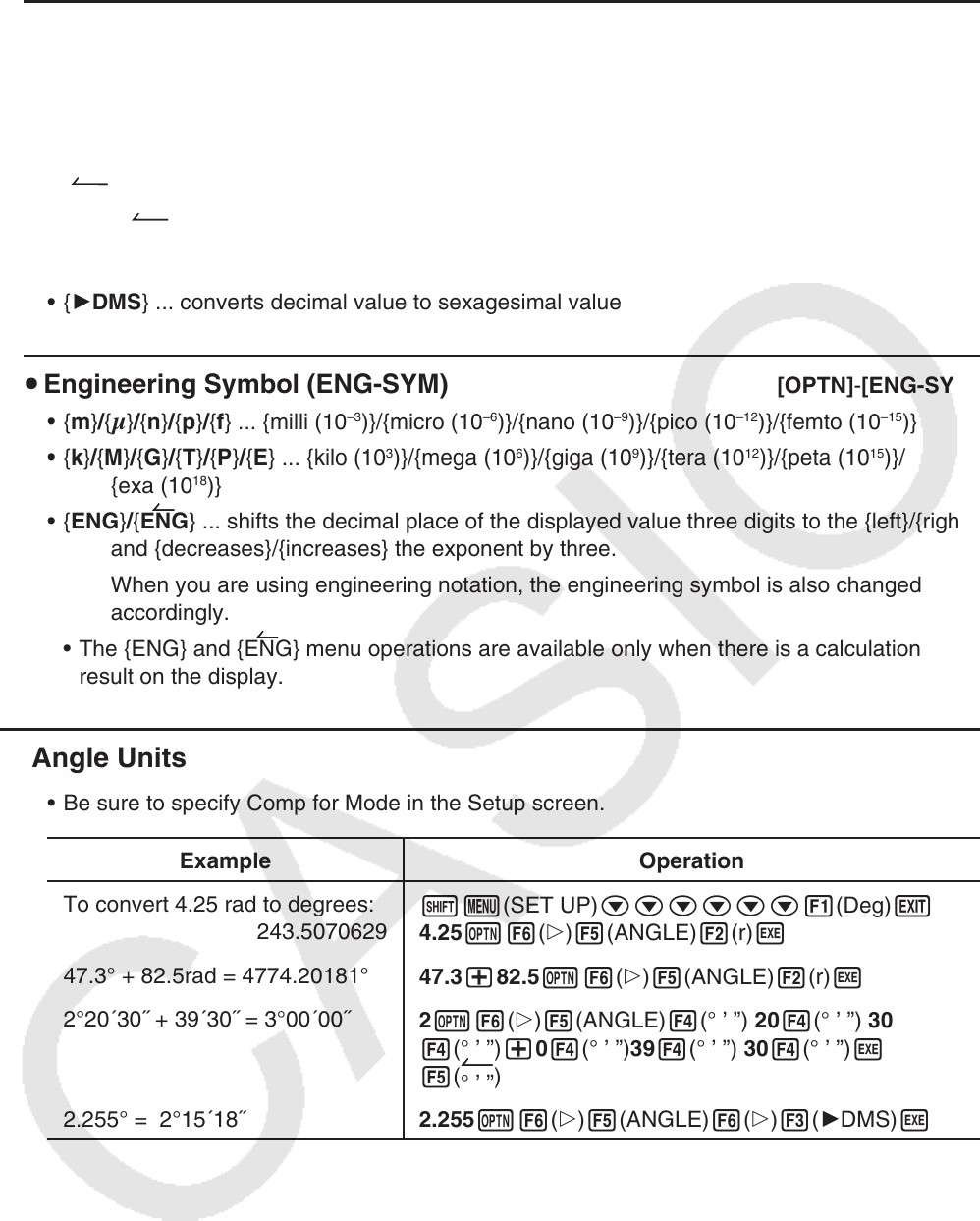User Manual
Table Of Contents
- Contents
- Getting Acquainted — Read This First!
- Chapter 1 Basic Operation
- Chapter 2 Manual Calculations
- 1. Basic Calculations
- 2. Special Functions
- 3. Specifying the Angle Unit and Display Format
- 4. Function Calculations
- 5. Numerical Calculations
- 6. Complex Number Calculations
- 7. Binary, Octal, Decimal, and Hexadecimal Calculations with Integers
- 8. Matrix Calculations
- 9. Vector Calculations
- 10. Metric Conversion Calculations
- Chapter 3 List Function
- Chapter 4 Equation Calculations
- Chapter 5 Graphing
- 1. Sample Graphs
- 2. Controlling What Appears on a Graph Screen
- 3. Drawing a Graph
- 4. Saving and Recalling Graph Screen Contents
- 5. Drawing Two Graphs on the Same Screen
- 6. Manual Graphing
- 7. Using Tables
- 8. Modifying a Graph
- 9. Dynamic Graphing
- 10. Graphing a Recursion Formula
- 11. Graphing a Conic Section
- 12. Drawing Dots, Lines, and Text on the Graph Screen (Sketch)
- 13. Function Analysis
- Chapter 6 Statistical Graphs and Calculations
- 1. Before Performing Statistical Calculations
- 2. Calculating and Graphing Single-Variable Statistical Data
- 3. Calculating and Graphing Paired-Variable Statistical Data (Curve Fitting)
- 4. Performing Statistical Calculations
- 5. Tests
- 6. Confidence Interval
- 7. Distribution
- 8. Input and Output Terms of Tests, Confidence Interval, and Distribution
- 9. Statistic Formula
- Chapter 7 Financial Calculation
- Chapter 8 Programming
- Chapter 9 Spreadsheet
- Chapter 10 eActivity
- Chapter 11 Memory Manager
- Chapter 12 System Manager
- Chapter 13 Data Communication
- Chapter 14 Geometry
- Chapter 15 Picture Plot
- Chapter 16 3D Graph Function
- Appendix
- Examination Mode
- E-CON4 Application (English)
- 1. E-CON4 Mode Overview
- 2. Sampling Screen
- 3. Auto Sensor Detection (CLAB Only)
- 4. Selecting a Sensor
- 5. Configuring the Sampling Setup
- 6. Performing Auto Sensor Calibration and Zero Adjustment
- 7. Using a Custom Probe
- 8. Using Setup Memory
- 9. Starting a Sampling Operation
- 10. Using Sample Data Memory
- 11. Using the Graph Analysis Tools to Graph Data
- 12. Graph Analysis Tool Graph Screen Operations
- 13. Calling E-CON4 Functions from an eActivity

2-15
u Angle Units, Coordinate Conversion, Sexagesimal Operations (ANGLE)
[OPTN]-[ANGLE]
• {°}/{r}/{g} ... {degrees}/{radians}/{grads} for a specific input value
• {° ’ ”} ... specifies degrees (hours), minutes, seconds when inputting a degrees/minutes/
seconds value
• {
° ’ ”
} ... converts decimal value to degrees/minutes/seconds value
• The {
° ’ ”
} menu operation is available only when there is a calculation result on the display.
• {Pol(}/{Rec(} ... {rectangular-to-polar}/{polar-to-rectangular} coordinate conversion
• {'DMS} ... converts decimal value to sexagesimal value
u Engineering Symbol (ENG-SYM) [OPTN]-[ENG-SYM]
• {m}/{
}/{n}/{p}/{f} ... {milli (10
–3
)}/{micro (10
–6
)}/{nano (10
–9
)}/{pico (10
–12
)}/{femto (10
–15
)}
• {k}/{M}/{G}/{T}/{P}/{E} ... {kilo (10
3
)}/{mega (10
6
)}/{giga (10
9
)}/{tera (10
12
)}/{peta (10
15
)}/
{exa (10
18
)}
• {ENG}/{ENG} ... shifts the decimal place of the displayed value three digits to the {left}/{right}
and {decreases}/{increases} the exponent by three.
When you are using engineering notation, the engineering symbol is also changed
accordingly.
• The {ENG} and {ENG} menu operations are available only when there is a calculation
result on the display.
k Angle Units
• Be sure to specify Comp for Mode in the Setup screen.
Example Operation
To convert 4.25 rad to degrees:
243.5070629
!m(SET UP)cccccc1(Deg)J
4.25K6(g)5(ANGLE)2(r)w
47.3° + 82.5rad = 4774.20181°
47.3+82.5K6(g)5(ANGLE)2(r)w
2°20´30˝ + 39´30˝ = 3°00´00˝
2K6(g)5(ANGLE)4(° ’ ”) 204(° ’ ”) 30
4(° ’ ”)+04(° ’ ”)394(° ’ ”) 304(° ’ ”)w
5(
° ’ ”
)
2.255° = 2°15´18˝
2.255K6(g)5(ANGLE)6(g)3('DMS)w










